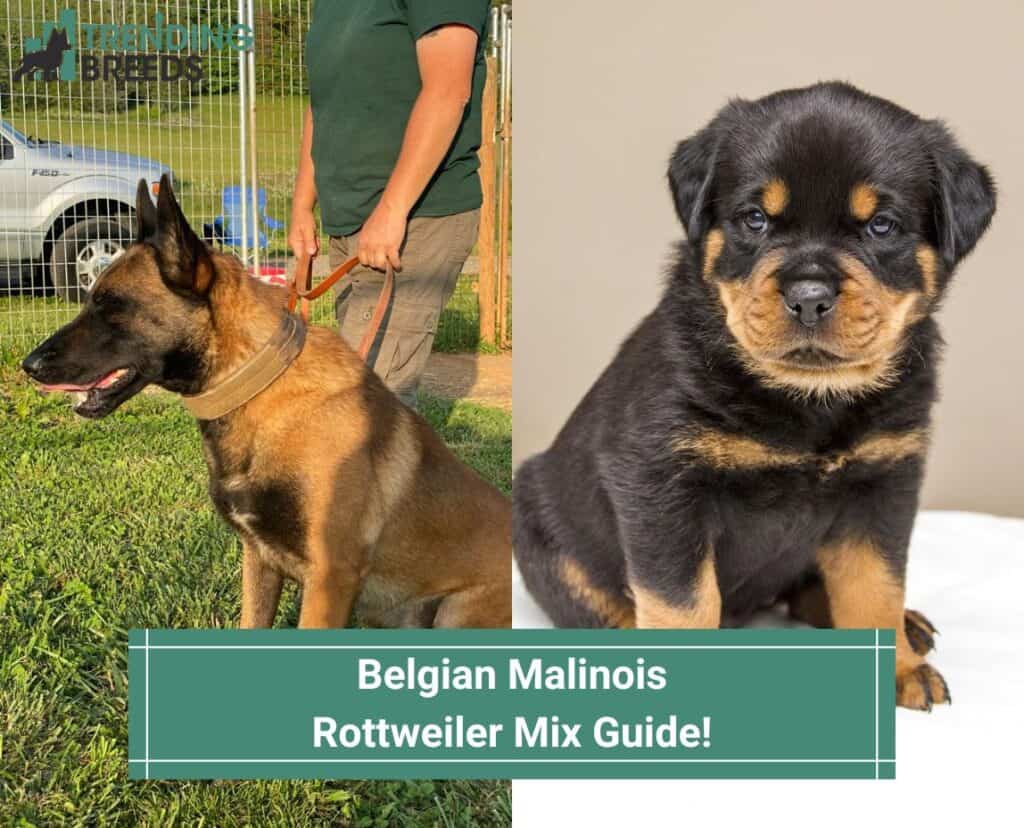
Belgium and Germany are the countries where the Belgian Malinois originates. 1959 was the first year that it was recognized as a breed in the United States.
In spite of its original purpose as a herding dog, the Malinois has proven to be an excellent police dog due to its intelligence and protective nature. Besides working with the military, Malinois are excellent at search and rescue missions.
White House security is even provided by this breed. As far back as the Roman Empire, the Rottweiler has a rich history.
Originally bred to herd livestock and pull carts, Rottweilers are similar to their Malinois counterparts. Police dogs and search-and-rescue dogs are also known to work with Rottweilers.
Other articles you would like: Are Rottweilers Good Guard Dogs? and Do Belgian Malinois Shed?
Table of Contents
Origin of the Belgian Malinois Rottweiler Mix
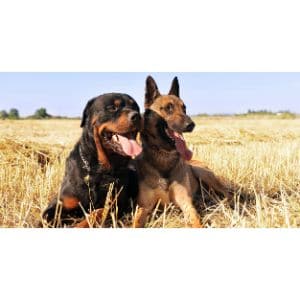
Mixes of Rottweilers and Malinois are relatively new. Rottweilers and Malinois are similar in some ways, especially when it comes to temperament and history.
Potential owners can anticipate an intelligent, highly energetic, and protective dog. Is there anything else you should prepare for?
How Big Do They Get?

As a medium to large dog, the Rottweiler and Belgian Malinois will grow in size. It is estimated that Malinois males weigh between 55 and 66 pounds and are about 26 inches tall.
The average height of a woman is 22-24 inches, and her weight ranges from 45-55 pounds. Rottweilers grow to a height of 24 to 27 inches and weigh 110 to 130 pounds, a bit bigger than other breeds.
In comparison, females average 22-25 inches tall and weigh 77-110 pounds, about the same as their male counterparts, but not by much.
Belgian Malinois Rottweiler Mixes are big dogs because they combine the two breeds. The size of your puppy will not tell you whether it will be a larger Rottweiler or a smaller Malinois.
Are They A Healthy Mix?

With diligent care, your mix should live between 11 and 14 years. Depending on the parent breeds, you may encounter the following problems.
Hip Dysplasia
The Belgian Malinois is one of the breeds most at risk for hip dysplasia, which can affect any dog breed.
Additionally, mastiffs and Rottweilers are more prone to hip dysplasia than German shepherds, Great Danes, Labrador retrievers, St. Bernards, or Labrador retrievers.
The ball needs to fit perfectly in a normal hip joint so that the joint can move smoothly. Hip dysplasia results in partial dislocation of the hip due to improper joint development.
Joints grind and rub rather than move fluidly, resulting in discomfort and loss of mobility as the joint deteriorates.
Elbow dysplasia
A dog’s elbow joint suffers from dysplasia due to a developmental condition called canine elbow dysplasia.
Your veterinarian may suspect elbow dysplasia when signs of lameness in your puppy’s front legs appear, especially if your dog has not been injured or involved in an accident.
Cataracts
Cataracts develop in dogs as they age, just as humans do. Light cannot enter the eye’s lens because of a cloudy film that sets on the lens. There is water and protein in your dog’s eyes.
An eye cataract occurs when protein clumps together in the eye’s lens and forms a cloud-like substance.
Eventually, the entire lens becomes clouded with proteins. There are two types of cataracts: small ones that grow bigger over time or large ones that appear overnight and completely blind your dog.
Progressive Retinal Atrophy
A hereditary defect in PRA leads to the death of rod cells of the retina. The disease destroys night vision in both eyes, followed by loss of day vision, which eventually causes total blindness.
The gradual loss of your dog’s sight may not be noticeable to you at first. When your dog’s senses gradually deteriorate, he will learn to use other senses to get around. As the eyes gradually become opaque, cataracts will form in the center.
Low thyroid
Low thyroid disease causes dogs to have thyroids that aren’t producing enough hormones to maintain normal metabolism.
A dog with low thyroid is likely to lose hair, particularly along the tail and flank sides. Dogs can have genetically low thyroid levels.
Von Willebrand’s
Some dogs suffer from Von Willebrand’s disease. Humans can also contract the disease, but humans can’t catch it from dogs, and dogs can’t catch it from humans. Dogs with the syndrome are genetically predisposed to it.
What Do They Look Like?
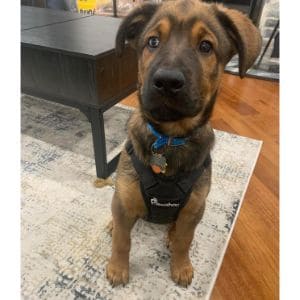
The temperament of Rottweiler Malinois Mix dogs varies greatly. We are witnessing crossbreeding here, my friends. Because of its parents’ very different looks, it will have a different appearance.
There are even differences within litters. Sometimes a puppy’s physical appearance is influenced by one parent over the other, while at other times, it is influenced by both parents equally.
What physical characteristics are likely to be inherited by your Rottweiler Malinois Mix?
Brawn over beauty was the Malinois’ breeding goal. Its appearance varies despite its purebred status. Malinois coats are typically tan to mahogany in color. Black masks are sometimes worn on the face, and chest and toe patches are white.
Rottweilers are recognizable to most people. This powerful dog breed stands out thanks to its distinctive black coat and mahogany markings.
A mahogany stripe runs along the snout and above each eye of these dogs. Both Rottweilers and Malinois puppies look different, so your puppy may be a mix of the two.
What Is Their Temperament?
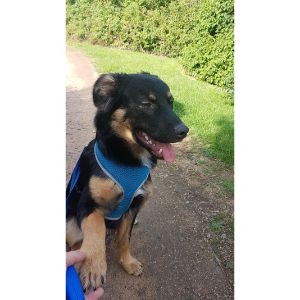
There is alertness, calmness, and intensity to a Malinois Rottweiler cross; it is watchful, intelligent, and energetic.
Due to the combination of both parents’ protective traits, the cross will make an excellent guard dog, protecting children, livestock, territories, and properties. For overt aggression to be prevented, socialization is essential.
Because the dog is large, energetic, and tends to herd small children, you must exercise caution with them.
The cross may not be suitable for households with multiple dogs unless it has been raised with them. However, you will need to assess your dog individually, as dog aggression is a trait of the Rottie parent.
Care Requirements

A high level of maintenance is involved with caring for a Rottweiler Malinois mix. A daily exercise routine of two hours or more is recommended for her.
Brushing must only be done every few days, so grooming is not as intensive. Fall and spring may be times when your dog sheds abundantly because both parent breeds have undercoats.
Temperatures between 30 and 85 degrees Fahrenheit are ideal for your dog.
Due to its dense undercoat, the Malinois can circulate cool air and protect itself from frigid weather.
Proteins and fats from animals are the primary ingredients of good-quality dog food. Depending on your dog’s age, activity level, and health, he or she will need 1,500 to 2,000 calories daily.
Dogs with crossed stomachs are more prone to bloating if fed divided food portions.
All dogs should have their nails trimmed every four to six weeks, their ears checked for redness, and bathed every six to eight weeks.
Do They Get Along With Other People and Animals?
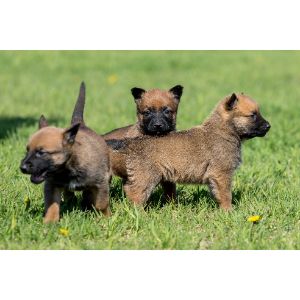
In addition to being extremely intelligent, Malinois and Rottweilers make excellent trainers. It will be a pleasure for them to follow commands because they enjoy challenges.
You should remember that both dogs were bred for work, so you should give the Malinois Rottweiler Mix at least an hour of exercise every day.
There is a strong potential for guardian behavior in both Malis and Rotties. To ensure a successful puppy adoption, get to know both parents first. Being a stranger, you should make them feel comfortable in your presence.
Despite this, you must engage in some intensive socialization to reduce the risk of inappropriate guarding around your house.
When your puppy is eight weeks old, bring him or her to a busy area where new people will meet him or her every day.
Visit your house every day with a variety of people. The puppy should be greeted positively and kindly, and guests should be associated with a pleasant experience.
Socialization should continue until your baby turns 14 weeks old, when the window of opportunity for socialization will close. In order to avoid things slipping after that point, continue introducing them to new people once a week at the very least.
Are They Easy To Train?
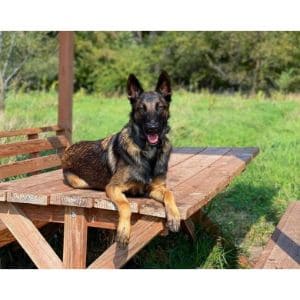
A collar and leash will help you control and limit your dog’s movements. A dog trainer or owner may use a prong or pinch collar on their dog.
Using a safe collar is the best option if you want to train your dog to walk on a loose leash and pull on the leash.
Make sure that you tighten the collar gently and don’t overdo it. Between the collar and the dog’s neck, two fingers should always fit.
Each leash has its own purpose, so it is important to have at least two short and one long.
Belgian Malinois pulling and jumping up while walking on a leash are advised to undergo short training. Also, it allows your Belgian Malinois puppy to learn how to walk with you.
Your Mal will learn to behave publicly by walking on a loose leash. Also, it allows your Belgian Malinois puppy to explore, sniff, and run around with more freedom while remaining close to you.
Dogs tend to be more responsive and happier when given enough room to explore the world around them.
It might also be worth your while to keep a bit of time in your pocket… literally! To measure the time spent on teaching your Belgian Malinois new skills, keep a stopwatch in hand while training.
Neither too long nor too short should be the Belgian Malinois training regimen. Maintain a record of what your Mal tells you about his daily needs.
A positive reinforcement approach is incorporated into all methods of training dogs. It is called the miracle training method by all pet owners. Your Belgian Malinois puppy will not be trained successfully by positive reinforcement alone.
The most accurate way to describe positive reinforcement is as a “tool” combined with other training methods. If your puppy does something right, you can reward it with delicious snacks.
Find a snack your puppy goes crazy for and introduce positive reinforcement into your daily training! During dog training, you’ll want to take advantage of the fact that dogs are willing to do anything for a tasty treat.
You will also like:
For more Rottweiler Mixes, check out the video below:




